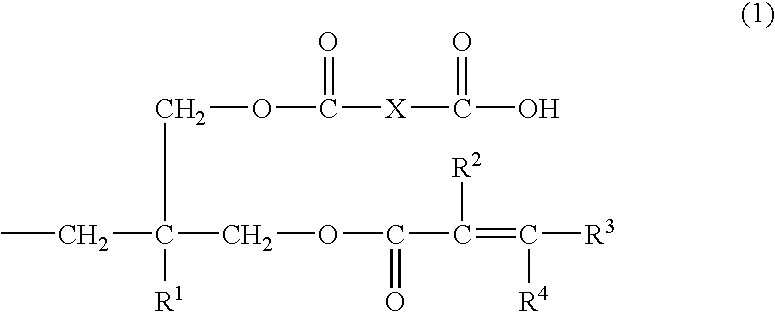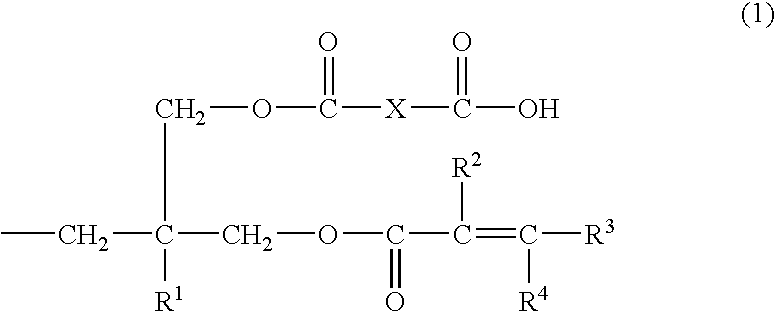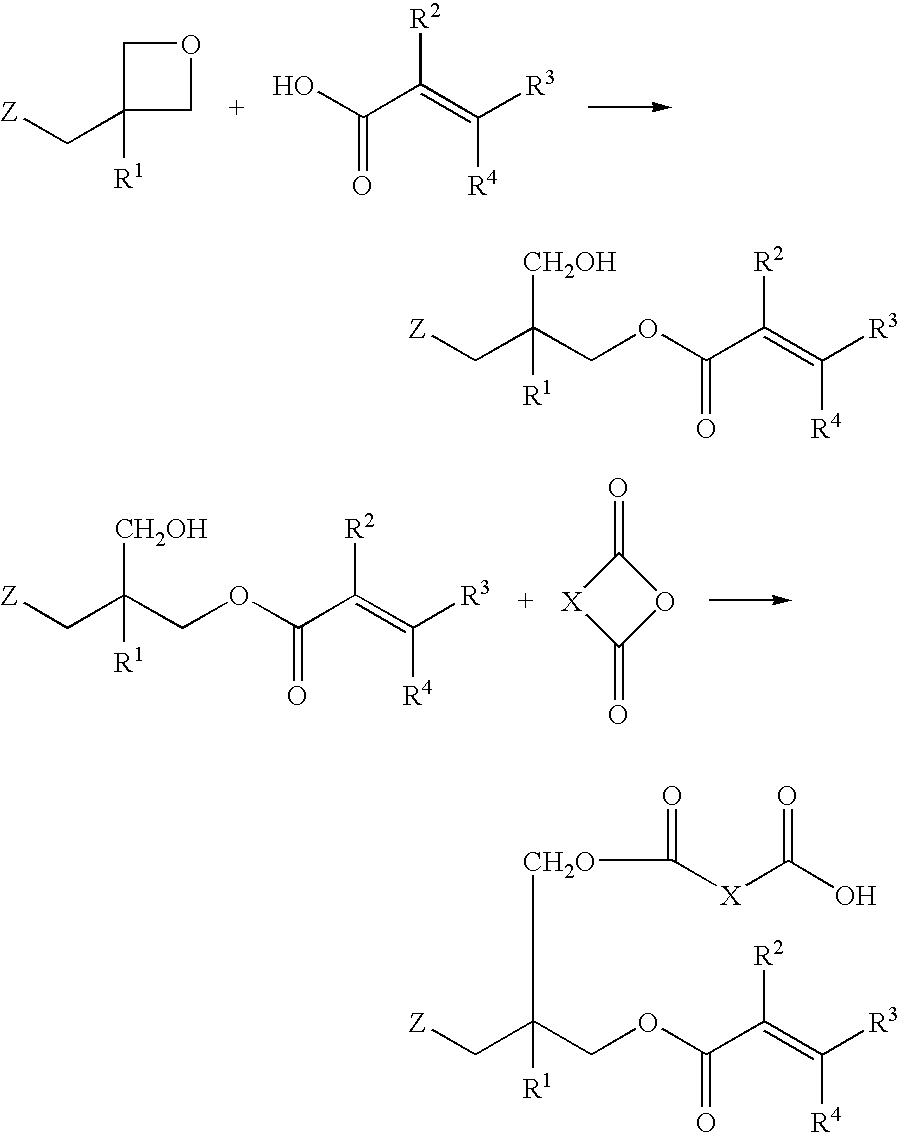Photocurable and thermosetting resin composition
a technology of thermosetting resin and photocurable resin, which is applied in the field of photocurable and thermosetting resin composition, can solve the problems of affecting the performance of the circuit, and causing the possibility of degradation of insulation properties and resistance to heat and contamination of circuits
- Summary
- Abstract
- Description
- Claims
- Application Information
AI Technical Summary
Benefits of technology
Problems solved by technology
Method used
Image
Examples
synthesis example 1
Into a 200 ml four-necked flask equipped with a stirrer, a reflux condenser, and a thermometer, 36.2 g (0.1 mol) of terephthalate bisoxetane (manufactured by Ube Kosan K.K.), 17.2 g (0.2 mol) of methacrylic acid, 2.1 g (0.005 mol) of tetraphenylphosphonium bromide, and 0.1 g of methoquinone were charged and stirred at 140° C. for 12 hours. After the decrease in absorption caused by the oxetane ring at 980 cm−1 has been confirmed by IR spectrum and the reduction of the acid value to a level of not more than 20 mg KOH / g has been also confirmed, the temperature of the reaction mixture was lowered to 100° C. and then 18.0 g (0.118 mol) of tetrahydrophthalic anhydride was added to the mixture. The mixture was further stirred at 100° C. for 3 hours. The product obtained had an acid value of 157 mg KOH / g.
It could be confirmed by the IR spectrum of the product obtained that the absorption of the primary hydroxyl group and the acid anhydride disappeared and the broad absorption originated fr...
synthesis example 2
Into a 200 ml four-necked flask equipped with a stirrer, a reflux condenser, and a thermometer, 33.4 g (0.1 mol) of xylylene bisoxetane (manufactured by Toa Gosei K.K., product name “XDO”), 17.2 g (0.2 mol) of methacrylic acid,2.1 g (0.005 mol) of tetraphenylphosphonium bromide, and 0.1 g of methoquinone were charged and stirred at 130° C. for 24 hours. After the reduction of the acid value to a level of not more than 20 mg KOH / g has been confirmed, the temperature of the reaction mixture was lowered to 100° C. and then 18.0 g (0.118 mol) of tetrahydrophthalic anhydride was added to the mixture. The mixture was further stirred at 100° C. for 3 hours. The product obtained had an acid value of 147 mg KOH / g. The resultant product was soluble in an aqueous 1% sodium carbonate solution. Hereinafter, this resin solution will be referred to as “varnish-B”.
synthesis example 3
2.04 g of phenol novolak type oxetane (number of nuclei=7) and 0.86 g of methacrylic acid, 0.21 g of tetraphenylphosphonium bromide, 3.0 g of propylene glycol monomethyl ether acetate, and 0.01 g of methoquinone added thereto were stirred at 140° C. for 24 hours. The reaction temperature was lowered to 100° C. and then 0.92 g of tetrahydrophthalic anhydride was added to the mixture. The mixture was further stirred for 3 hours. The product obtained had an acid value of 84 mg KOH / g. Hereinafter, this resin solution will be referred to as “varnish-C”.
PUM
| Property | Measurement | Unit |
|---|---|---|
| Percent by mass | aaaaa | aaaaa |
| Percent by mass | aaaaa | aaaaa |
| Percent by mass | aaaaa | aaaaa |
Abstract
Description
Claims
Application Information
 Login to View More
Login to View More - R&D
- Intellectual Property
- Life Sciences
- Materials
- Tech Scout
- Unparalleled Data Quality
- Higher Quality Content
- 60% Fewer Hallucinations
Browse by: Latest US Patents, China's latest patents, Technical Efficacy Thesaurus, Application Domain, Technology Topic, Popular Technical Reports.
© 2025 PatSnap. All rights reserved.Legal|Privacy policy|Modern Slavery Act Transparency Statement|Sitemap|About US| Contact US: help@patsnap.com



